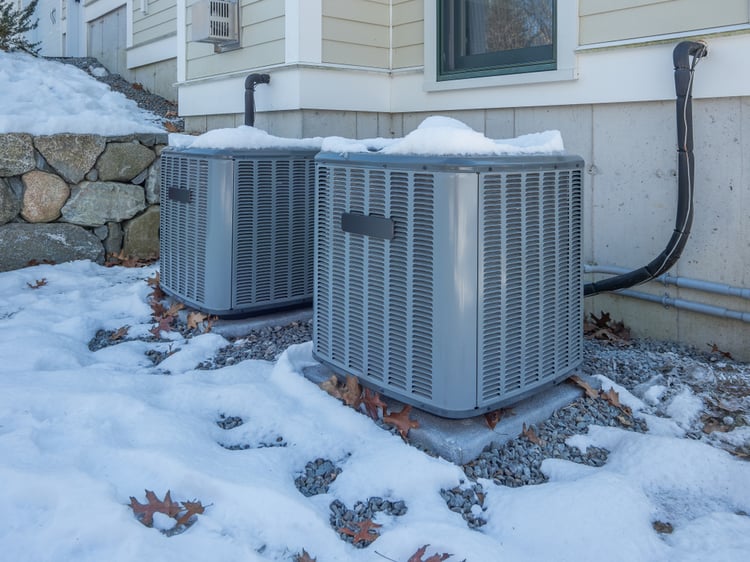Starting in 2024, New York City buildings will be forced to meet certain emission limits . Otherwise, a fine of US$268/year will be charged for each metric ton of CO2 equivalent above the limit. Emissions can be reduced by improving energy efficiency in buildings, but switching to cleaner energy sources is also a viable strategy. For example, natural gas is a cleaner option than No. 2 fuel oil, and on-site solar is cleaner than grid electricity.
- All energy sources have a price, which can take the form of a utility charge or a cost of ownership.
- For example, solar panels produce electricity with free energy input, but involve an initial investment and ongoing maintenance.
Energy consultants often recommend energy efficiency first and switching to cleaner sources as a second step. If a building can become more efficient first, on-site generation can cover a larger fraction of its energy needs.
Replace your oil boilers with high-efficiency heat pumps and reduce your building's emissions.
In this article, we will discuss the potential savings when buildings use efficient electric heating instead of burning fossil fuels. Electric resistance heaters are not viable for many building owners due to their operating cost, especially in places with high electricity rates like New York. However, there are now high-efficiency heat pumps that can match the cost of gas heating.
Calculation of building emissions according to local legislation 97

Local Law 97 of 2019 was part of the Climate Mobilization Act, often called New York's Green New Deal. The law introduces building emission limits that will apply from 2024, and the specific limit for a building depends on its occupancy classification and square footage. For example, a 200,000 m² building classified as Business Group B will be subject to a limit of 1,692 tCO2e/year in 2024, but a building of the same size classified as Residential Group R-2 has a lower limit of 1,350 tCO2e/year.
The law also provides emission factors for the different energy sources used by buildings. For example, 100,000 kBTU of #4 fuel oil would add 7.53 tCO2e to building emissions, while 100,000 kBTU of natural gas would add 5.31 tCO2e. Assuming constant energy consumption, switching from #4 fuel oil to natural gas would reduce emissions by almost 30% in this case.
With a conversion to electric heating , emissions can decrease or increase depending on the technology used. For example, an electric resistance heater using grid electricity produces much higher emissions than a geothermal heat pump using a combination of grid electricity and solar energy.
Estimating emissions from electrically heated buildings

As an example of how electric heating can reduce building emissions , we will estimate the metric tons of CO2 equivalent for the following heating equipment, assuming an output of 500,000 kBTU in all cases. Keep in mind that this is a very simplified calculation, intended to demonstrate how heating emissions compare with different technologies – only energy modeling can produce accurate results.
- An oil boiler (no. 2 fuel oil) with an efficiency of 87%.
- Natural gas boiler with 90% efficiency.
- An electric resistance heater.
- An air source heat pump with a COP of 3.
- A geothermal heat pump with a COP of 5.
The following table calculates the energy input required to achieve 500,000 kBTU of heating in all five cases. The energy input is then multiplied by the corresponding emissions factor of the LL87:
|
Heater |
Power Input |
LL87 emissions (tCO2e) |
|
Oil boiler |
574,713kBTU |
42.65 tCO2e |
|
Gas water heater |
555,556kBTU |
29.51 tCO2e |
|
Electric Resistance Heater |
146,542 kWh |
42.35 tCO2e |
|
Air Source Heat Pump |
48,847 kWh |
14.11 tCO2e |
|
Geothermal heat pump |
29,308 kWh |
8.47 tCO2e |
The corresponding emission factors of LL97 are 0.00005311 tCO2e/kBTU for natural gas, 0.00007421 tCO2e/kBTU for #2 fuel oil, and 0.000288962 tCO2e/kWh for grid electricity. Notice how the oil boiler and electric resistance heater have about the same emissions, and natural gas heating is about 30% cleaner than both. The aerothermal heat pump produces around 52% less emissions than the gas boiler, while the geothermal heat pump produces around 71% less.
- In this example, we assume that all electricity comes from the New York grid for the three electric heaters considered.
- Lower emissions can be achieved if a building generates electricity on-site with clean technologies such as solar panels or wind turbines.
- For example, if the aerial heat pump obtains 15,000 kWh of solar electricity, emissions will only be calculated for the remaining 33,847 kWh. Instead of 14.11 tCO2e, ASHP would be producing 9.78 tCO2e.
Electric heating systems have the flexibility to switch from grid electricity to clean energy generated on site, whereas oil and gas boilers are limited to their respective fuels. High-efficiency heat pumps can play an important role in decarbonizing New York City buildings, as space heating is the top energy expense for many properties.
Conclusion
Emissions from buildings can be reduced by upgrading from combustion heating to electric heating. However, this only applies to high-efficiency heat pumps, as resistance heaters can be even more polluting than gas boilers. Even though a resistance heater uses clean energy generated on site, its high energy consumption is still a disadvantage. Depending on its design, a heat pump can consume 2 to 6 times less electricity than an equivalent resistance heater and emissions are reduced accordingly.

